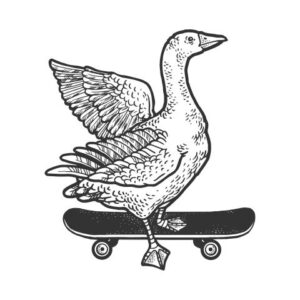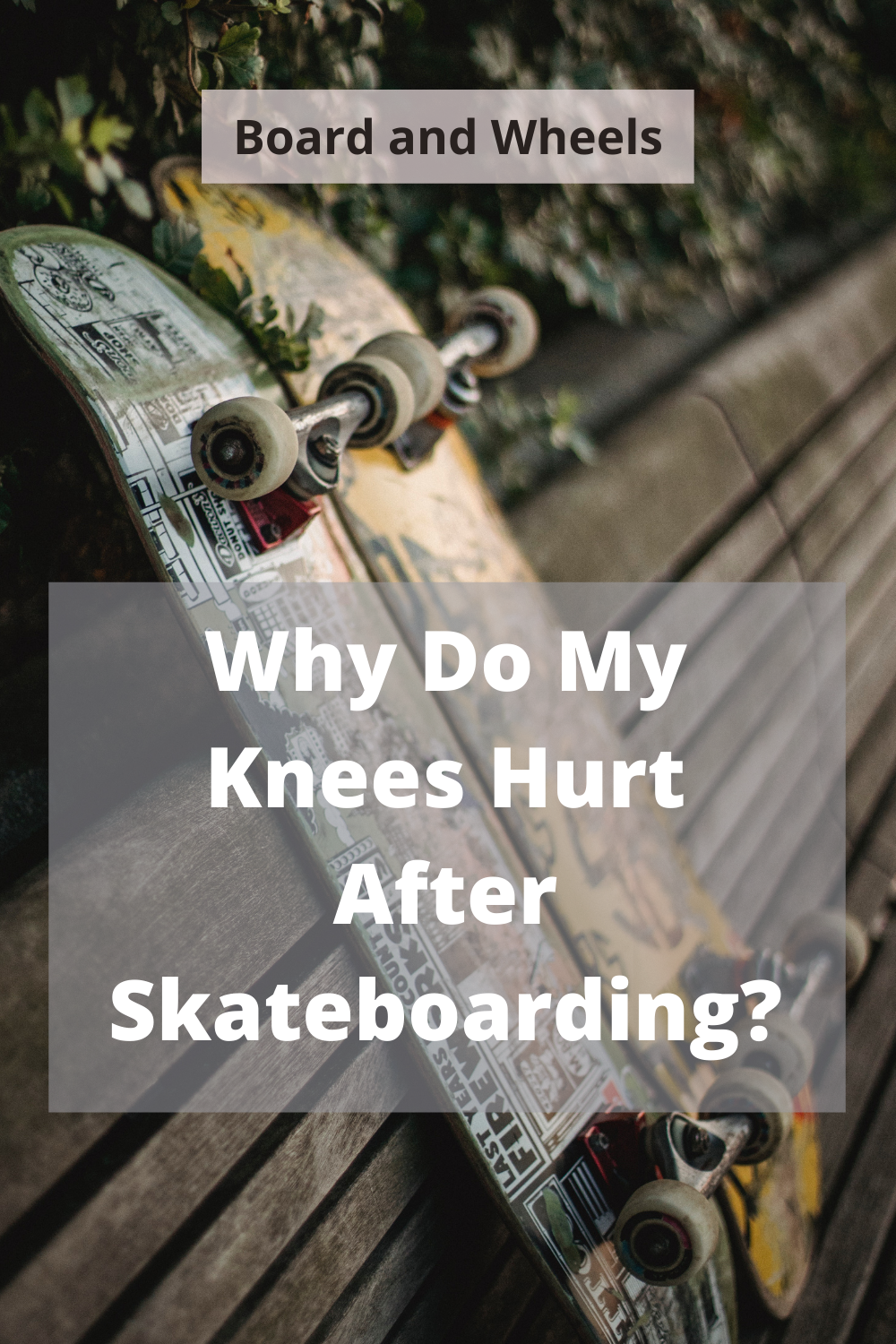Everyone’s body breaks down eventually, and certain exercises don’t help. Squatting, running, and skateboarding are some things that are rough on the knees. In particular, I get knee pain when doing flatground tricks that require an ollie.
Knees take the majority of an impact force in skateboarding. Many tricks that require an ollie on flat ground can put a lot of stress on the knees. Especially if you are doing a trick off of a ledge or a set of stairs, skateboarding can wear down and even injure your knees. If you have issues with knee pain and injuries, try and focus on transition skating instead of street skating.
This is a reality of the sport. However, there are things you can do to prevent knee pain and mitigate any stress you receive. However, Board and Wheels is not a health organization and it is always best to consult with your doctor.
Why Do My Knees Hurt After Skateboarding?
I am familiar with knee pain. I went through a phase where I weight-lifted heavily and got knee pain during intense leg workouts. I used to play soccer and ultimate frisbee and would get knee pain after a weekend of sprinting and running.
I also get some knee pain when I skate for too long and practice ollie based tricks.
The force you create from jumping up and down is more higher than your normal body weight. This is because you essentially are falling from the highest point of your jump. While, you only fall for maybe half a second, you gain a lot of energy in this time.
If you fall for half a second you are moving at a rate of 5 meters/second. The kinetic energy equation of 1/2*m*v^2 shows that velocity is a huge part of the energy equation. Even a little bit of speed results in a large amount of energy that your knees and back absorb as you land. If your knees don’t absorb this impact then you will fall like a rag doll on impact.
Especially if you’re battling a difficult trick for a few hours, how many times do you jump up while skating?
Honestly probably too many times to count.
This puts an incredible amount of stress on your knees, but luckily there are some ways that you can mitigate knee pain with skateboarding.
Let’s go over how we can prevent knee pain while skateboarding.

How to Prevent Knee Pain While Skateboarding
For some people knee pain is an inevitability while skateboarding. Fortunately, a small amount of knee discomfort or pain doesn’t mean you need to quit skateboarding. Actually, after the stress of a workout or skate session, knee discomfort isn’t unexpected.
There are some things you can do to mitigate knee pain from skateboarding and these are tips you should take if you suffer from knee pain. Especially if you are an older skater or have a history of injuries, this advice applies to you.
If you want to know about how to get started skateboarding as an adult with a reality check, read our guide here.
Strengthen Your Muscles at the Gym
The absolute best thing you can to take some stress off of your lower back and knees is to build muscle up that can absorb some of the impact force.
You will need to focus on building up your quads to support your knees and your hamstrings/lower back to help from buckling on impact. Even a small, consistent workout routine can help immensely.
If you are a beginner, I would recommend working out 2-days a week at the gym. One day will be focused on your legs and lower body. The other day will be focused on your back and upper body.
These workouts are exercises I use and created. Specifically, they can be done at home if you have a set of dumbbells and don’t take much time to do.
- MONDAY——Chest and Back
- 1) push-ups – 4 sets of 25 with 1 minute of rest in-between
- rest 2 minutes
- 2) straight leg deadlights with dumbbell – 4 sets of 20 with 1 minute of rest in-between
- rest 2 minutes
- 3) rows with dumbbell- 4 sets of 25 on each side with 1 minute of rest in-between
- rest 2 minutes
- 4 planks – 3 sets for 1 minute each with 1 minute of rest in-between
- WEDNESDAY——Legs
- 1) squats with dumbbell – 4 sets of 25 with 1 minute of rest in between
- rest 2 minutes
- 2) side leg raises – 4 sets of 45 on each side with 1 minute of rest in-between
- rest 2 minutes
- 3) calf-raises on whatever – 4 sets of 50 with 1 minute of rest in-between
- rest 2 minutes
- 4) planks – 3 sets for 1 minute each with 1 minute of rest in-between
If you can implement this workout consistently, it will be a fantastic beginning to strengthening your legs and upper body in a way that will help support your knees.
These exercises only take about an hour or so to do, but are intense. The short rest in-between each exercise is critical to the workout.
Wear Skateboarding Insoles
Skateboarding insoles are designed to absorb part of the impact of landing and in an impact-heavy sport, they can be a lifesaver. There are quite a few good skate shoe insole guides out there so just find one you like and go wild.
Personally, I’ve never used insoles for skating, but we’re going to buy and test a few types in the coming months so lookout for an update here.
Take Fish Oil Supplements
Your knee is lubricated by oils and if you lack this lubrication, then you can take fish oil pills to help relieve knee pain symptoms. Fish oil contains Omega-3 fatty acids that can reduce inflammation, certain kinds of arthritis, and help restore joint tissue.
This is researched and scientifically proven so don’t think this is some holistic remedy.
You can find fish oils pills at most convenience stores or any Walgreens and CVS in the United States. They’re cheap and easy to take. Take them.

Warm-Up Before Skating
You body isn’t instantly ready to go. Before exercising or skating you will need to warm up.
A warmup gradually revs up your cardiovascular system by raising your body temperature and increasing blood flow to your muscles. Warming up may also help reduce muscle soreness and lessen your risk of injury (source).
The same applies to skating. Particularly in the case of certain tricks, the body needs to perform explosive movements. These movements can cause an injury if the muscle is cold and not properly warmed up. You can also lose proper form and put more pressure on your knees if you are not warmed up.
Examples of explosive movement would be high ollies, 180 and 360 tricks, and power slides.
You can warm up by first riding around on your board while doing no tricks. Crouch down and hold a crouched position. Stretch out your back and legs by touching your toes and doing a couple squats. Just get the blood moving to your muscles.
Bend Your Knees On Impact
This one usually goes without saying, but occasionally someone needs this advice.
Bend your knees when you land.
This helps your muscles absorb a large portion of the impact upon landing. This comes naturally to most people, but sometimes it can be easy to stiffen up, especially if you are nervous. I like to squat on the board at the beginning of a session to warm up.
If you want to know whether overweight people can skate, check out our guide here.
Don’t Push Yourself Too Hard
Finally, you just shouldn’t push yourself too hard. It is better to live and skate another day than to push yourself to hard.
Your body will take time to recover and skating will put pressure and wear out your knees and back. So try not to skate for more than a couple hours at a time. Give yourself a rest day before getting back out there.
If you run your body into the ground, you will be forced to stop skating at a much earlier age.
I prefer to just mind what my body is telling me. If my knees or back start experiencing discomfort then I start to wind down the session. Sometimes I skate for a long time with no discomfort or pain. Sometimes I stop after just an hour or an hour and a half.
Just listen to your body.
Is Skateboarding Bad for Your Knees?
Like many sports, skateboarding can wear down your body. In particular, skateboarding can put a lot of stress on your knees and back.
Skateboarding can be hard on your knees if you perform a lot of technical tricks in the street style of skating. However, transition skating puts minimal stress on the knees and is more suitable for older skaters or those who a history of injuries.
Knee pain doesn’t always mean there is a serious problem. Overuse injuries are quite common and not serious. They just require some time off and rest. These include runner’s knee and jumper’s knee. Dull pain might not be serious, but any sharp pains should be taken seriously and you should see a health professional.
Make sure you the knee pain prevention steps outlined in this article. Also, you should always get the opinion of a doctor if you are experiencing knee pain.

Conclusion
Just like any other intense exercise, skateboarding can be rough on your body. In particular, skateboarding puts a lot of stress on your knees and back.
You can mitigate this by building up supporting muscle, taking fish oil pills, warming up before a session, bending your knees, and by not pushing yourself too hard.
Skateboarding isn’t bad for your knees, but it can absolutely put a lot of stress and strain on your knees and back. You should mitigate that by practicing prevention. Eventually, bad habits will catch up to you.
Anyway that’s all. Look out for more articles from Board and Wheels.



